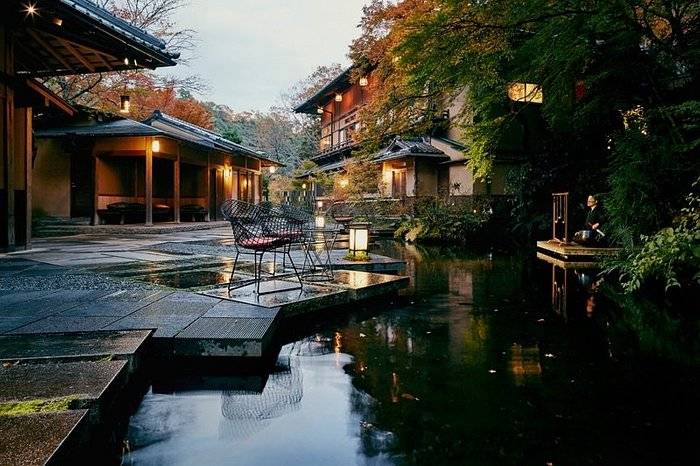
Discover Kyoto: The Perfect Blend of Tradition and Modernity
Kyoto has always been a dream destination for travelers seeking a rich cultural experience. With its timeless temples, traditional tea houses, and breathtaking gardens, It remains a top travel destination in 2025. However, the city has also embraced innovation, blending ancient heritage with modern advancements. Whether you’re a history enthusiast, a foodie, or an adventurer, it offers something unique for every traveler. Here are 7 Top Travel Destinations in Kyoto, Japan
1. Fushimi Inari Shrine
Fushimi Inari Shrine is one of the most iconic landmarks in Kyoto. Known for its thousands of vermillion torii gates, this sacred site offers an enchanting walk through the mountains. In 2025, new guided tours incorporate AR (Augmented Reality) technology, allowing visitors to visualize the shrine’s history and significance in an immersive way.
Highlights at Fushimi Inari:
- Walking through the breathtaking torii gate pathways.
- Enjoying new AR-guided historical tours.
- Visiting smaller, hidden shrines along the trail.
2. Arashiyama Bamboo Forest
The Arashiyama Bamboo Forest is a must-visit destination for nature lovers. The towering bamboo stalks create a surreal, tranquil atmosphere. In 2025, eco-friendly pathways and guided night walks with soft illuminations have been introduced, enhancing the experience while preserving the forest’s natural beauty.
Highlights at Arashiyama:
- Walking through the mesmerizing bamboo groves.
- Experiencing night-time bamboo illuminations.
- Exploring nearby Tenryu-ji Temple and its Zen gardens.
Arashiyama Bamboo Forest is one of Japan’s most iconic natural destinations, located in the Arashiyama district of Kyoto. Dating back to the Heian period (794-1185), this forest was a retreat for Japanese aristocrats. Its towering bamboo groves create a mesmerizing view and a tranquil atmosphere.
The forest is also considered a symbol of harmony between humans and nature in Japanese culture. The sound of rustling bamboo in the wind has even been designated as one of Japan’s “100 Soundscapes” by the Ministry of Environment.
Community Life and Tourist Attractions
Arashiyama Bamboo Forest plays a vital role in local life and tourism:
- Bamboo Pathway: A 500-meter scenic walkway with a magical ambiance.
- Tenryu-ji Temple: A UNESCO World Heritage Site near the forest.
- Autumn Festivals and Hanami: The best seasons to enjoy Arashiyama’s natural beauty.
Innovation and Technological Influence
The forest embraces modern innovations to ensure its preservation:
- Digital conservation system: Drones and AI monitor bamboo health.
- Eco-friendly lighting: LED installations enhance the nighttime experience.
- Digital promotion: Tourism campaigns via social media and virtual tours.
As a fusion of history, culture, and innovation, Arashiyama Bamboo Forest remains a breathtaking destination for visitors worldwide.
3. Kiyomizu-dera Temple – A View from the Heights
This UNESCO World Heritage Site remains a favorite among visitors. The temple, perched on a hill, provides panoramic views of Kyoto. In 2025, sustainable tourism efforts have made access to the temple more eco-friendly, including electric shuttle buses and expanded walking trails.
Highlights at Kiyomizu-dera:
- Taking in breathtaking views of Kyoto from the wooden terrace.
- Learning about sustainable preservation efforts.
- Exploring nearby historic streets filled with traditional shops.
Origins and Significance of Kiyomizu-dera Temple
Kiyomizu-dera is one of Japan’s most famous Buddhist temples, located in Kyoto. Established in 778 AD during the Heian period, the temple is dedicated to Bodhisattva Kannon, the goddess of mercy. The name “Kiyomizu” means “pure water,” referring to the Otowa Waterfall, which flows within the temple grounds and is believed to bring good fortune to those who drink from it.
The main attraction is the hondo (main hall), built on a massive wooden stage rising 13 meters high, without the use of nails. From here, visitors can enjoy breathtaking views of Kyoto, especially during the cherry blossom and autumn foliage seasons.
Community Life and Tourist Attractions
Kiyomizu-dera plays an essential role in Japan’s spiritual and cultural life:
- Seasonal Views: Cherry blossoms in spring and vibrant autumn leaves attract thousands of visitors.
- Rituals and Festivals: The Seiryu-e Festival and “Love Stones” at Jishu Shrine.
- UNESCO Cultural Heritage: Part of Kyoto’s Historic Monuments World Heritage Site.
Innovation and Technological Influence
The temple continues to evolve by embracing modern innovations:
- Digital Conservation: AI and 3D technology aid in preserving the temple’s structure.
- Virtual Tours: VR-based experiences allow global visitors to explore the temple remotely.
- Online Donation System: Enables worshippers to contribute to temple maintenance.
As a blend of history, culture, and innovation, Kiyomizu-dera remains an irreplaceable spiritual and tourist destination.
4. Nishiki Market – A Culinary Wonderland
Known as “Kyoto’s Kitchen,” Nishiki Market is the best place to explore culinary scene. In 2025, more vendors are offering plant-based and sustainable food options, catering to the growing interest in eco-conscious dining.
Highlights at Nishiki Market:
- Sampling fresh sushi, matcha desserts, and yuba (tofu skin).
- Enjoying new plant-based delicacies.
- Learning about Kyoto’s culinary traditions through cooking workshops.
Origins and Development of Nishiki Market
Nishiki Market, known as “Kyoto’s Kitchen,” is one of Japan’s most famous traditional markets. It originated in the 14th century as a fish trading hub and gradually evolved into a culinary center offering Kyoto’s finest delicacies. Located in Nakagyo District, Kyoto, the market features over 100 shops and stalls selling fresh seafood, local snacks, and traditional kitchenware.
Over the centuries, Nishiki Market has preserved its traditional atmosphere while embracing modern innovations to enhance visitor experiences. It remains one of Kyoto’s top culinary destinations, attracting tourists from around the world.
Significance in Community Life
Nishiki Market plays a vital role in Kyoto’s daily life:
- Source of Traditional Ingredients: Provides fresh, authentic ingredients for Kyoto cuisine.
- Culinary Hub: Offers street food specialties like yuba (tofu skin), takoyaki, and matcha treats.
- Cultural Heritage: An integral part of Kyoto’s food and historical identity.
Nishiki Market continues to be a cultural and culinary icon, bridging tradition and modernity in Kyoto.
5. Philosopher’s Path
Lined with cherry trees and historic temples, the Philosopher’s Path offers one of the most picturesque walks in this place. In 2025, guided walking tours now integrate interactive digital guides, providing insights into the philosophers and poets who once strolled this route.
Highlights at Philosopher’s Path:
- Walking along the scenic canal lined with cherry blossoms.
- Exploring hidden temples and shrines along the path.
- Engaging in interactive digital storytelling tours.
Origins and Development of Philosopher’s Path
Philosopher’s Path, or Tetsugaku no Michi, is a famous pedestrian trail in Kyoto, Japan. Stretching approximately 2 kilometers along the Biwa Canal, it connects Ginkaku-ji (Silver Pavilion) to Nanzen-ji Temple. The path was named after Nishida Kitaro, a renowned Japanese philosopher from the Meiji era, who frequently walked here for contemplation and deep thought.
Originally a simple route, it gradually gained recognition for its serene beauty, especially during spring when cherry blossoms bloom. The path’s association with philosophy and self-reflection has made it an iconic cultural landmark in Kyoto.
Significance in Community Life
Philosopher’s Path plays an essential role in the daily lives of many:
- Place for Reflection and Meditation: A favored route for those seeking peace and inspiration.
- Tourist Attraction: With cherry blossoms in spring and red foliage in autumn, it draws thousands of visitors annually.
- Cultural and Historical Hub: Surrounded by temples and historical sites reflecting Kyoto’s rich heritage.
Impact of Innovation and Technology
While maintaining its traditional charm, Philosopher’s Path has embraced modern innovations:
- Digital Guides: Travel apps now provide virtual tours and interactive insights.
- Environmental Conservation: Efforts are made to preserve the natural ecosystem along the path.
- Improved Accessibility: Infrastructure enhancements ensure a comfortable experience for visitors.
Philosopher’s Path remains a symbol of Kyoto’s beauty, where tradition and modernity coexist in harmony.
6. Kyoto’s Ryokan Experience

For an authentic Kyoto experience, staying in a ryokan (traditional Japanese inn) is a must. Many ryokans in 2025 have embraced sustainability, incorporating solar energy and locally sourced organic food.
Highlights of Staying in a Ryokan:
- Experiencing traditional tatami mat rooms and futons.
- Indulging in multi-course kaiseki meals made with seasonal ingredients.
- Relaxing in natural onsen baths with a view.
Ryokan, Japan’s traditional inns, have been around since the Edo period (1603-1868). In Kyoto, a city rich in history and culture, ryokan developed as a resting place for samurai, merchants, and pilgrims visiting temples and cultural centers. Unlike modern hotels, ryokan offers a unique experience featuring tatami mats, futons, hot spring baths (onsen), and Japan’s signature hospitality—omotenashi.
Some of Kyoto’s most renowned ryokan, such as Tawaraya and Hiiragiya, have been in operation for over 300 years, preserving Japanese traditions while offering a luxurious retreat.
Significance in Community Life
Ryokan are more than just accommodations; they play a crucial role in Japan’s cultural heritage:
- Preserving Traditions: Ryokan maintain Japan’s traditional lifestyle through architecture, cuisine, and etiquette.
- Tourism Attraction: As Kyoto’s cultural hub, ryokan attract visitors seeking an authentic Japanese stay.
- Supporting the Local Economy: Ryokan collaborate with local artisans for furnishings, kimonos, and traditional kaiseki meals.
Impact of Innovation and Technology
To stay relevant in the modern era, many ryokan in Kyoto have embraced innovation:
- Online Booking: Digital platforms make it easier for international travelers to book stays.
- Modern Comforts: Some ryokan incorporate modern amenities like Wi-Fi while preserving their traditional essence.
- Sustainability: Many ryokan are adopting eco-friendly practices to protect their surrounding environment.
By blending tradition with innovation, Kyoto’s ryokan remain a top choice for travelers seeking a harmonious fusion of history, culture, and modern comfort.
Read Also: 14 Top Destinations in Osaka, Japan
7. Kyoto International Manga Museum
Kyoto is home to one of Japan’s best manga museums. In 2025, the museum features more interactive exhibits, including VR experiences that allow visitors to step inside their favorite manga stories.
Highlights at Kyoto International Manga Museum:
- Browsing thousands of manga titles in multiple languages.
- Experiencing new VR manga immersion zones.
- Attending live artist workshops and cosplay events.
Conclusion
Kyoto continues to captivate travelers in 2025 by balancing tradition with modernity. Whether you’re drawn to its ancient temples, serene gardens, or innovative cultural experiences, Kyoto has something extraordinary to offer. As sustainability and technology reshape the travel landscape, Kyoto sets an example of how a city can preserve its heritage while embracing the future.
Are you planning a trip to this Country in 2025? Let us know your favorite spots in the comments!









